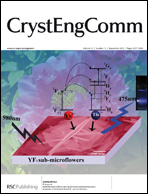In our continuous efforts to explore the effects of metal ions, ligands and counter anions on the structures and properties of metal–organic complexes, six transitional metal complexes with two structurally related ligands, 1,4-bis(1,2,4-triazol-1-ylmethyl)naphthalene (L1) and 4,4′-bis(1,2,4-triazol-1-ylmethyl)biphenyl (L2), [Cd(L1)2(NO3)2(H2O)]∞ (1), [Hg(L1)0.5(Br)2] (2), {[Mn(L1)2Cl2](H2O)8}∞ (3), {[Cu(L1)2Cl2](H2O)8}∞ (4), {[Cd(L2)2(CH3OH)2(NO3)2](H2O)}∞ (5) and [Cd(L2)3(CH3OH)2(ClO4)2(CHCl3)]∞ (6), were synthesized and structurally characterized. 1 has an infinite two-dimensional (2D) network structure and the 2D network further assembled into a 3D interpenetrating structure, 2 is a dinuclear structural molecule, 3 and 4 are neutral molecules with 1D chain structures and the same packing modes, and 5 and 6 have a similar structure, consisting of a 1D neutral coordination chain, but the coordination geometry around the CdII ion in 6 is different from that in 5. The results indicated that the structural differences among them are attributable to the difference of metal ions, counter-anions and ligands frameworks. All the complexes are air stable at room temperature. L1 and L2 adopt trans–gauche as well as gauche–gauche conformation with the shortest N⋯N distance between the two donors in all complexes. Furthermore, the fluorescent properties of complexes 1, 5, 6 and all ligands have been investigated and discussed.


 Please wait while we load your content...
Please wait while we load your content...